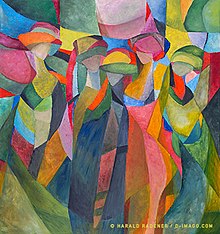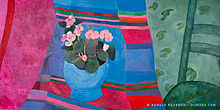Helga Radener-Blaschke
Helga Radener-Blaschke (born February 4, 1922 in Plettenberg / Sauerland ; † March 25, 2015 in Düsseldorf ) was a German painter , illustrator and graphic artist and worked on numerous art-in-building projects for public spaces. In 1977 she became the first full female member of the Malkasten artists' association .
Life
Born Helga Blaschke, she was the youngest of three children of the architect Julius Blaschke, BDA (1882–1971) and his wife, the art teacher Beata Blaschke-Fontaine (1886–1953). Her oldest brother Franz-Josef Blaschke (1916–1984) was also an artist and known as a portraitist , sculptor and art carver.
After studying to be a primary school teacher, Radener-Blaschke decided to attend the Cologne factory schools under the direction of August Hoff from 1947 . Starting in 1949, he started studying textile art at the Higher Technical School for Textile Surface Art / Textile Engineering School in Krefeld (today: Niederrhein University of Applied Sciences ). In 1951 she completed the master class for fashion drawing with Georg Muche with distinction.
In 1950 she married the Luftwaffe pilot Waldemar H. Radener , with whom she had two children. In 1953 the graphic artist and advertising designer Harald Radener and in 1955 the actress Bettina Radener were born. In January 1957 her husband had a fatal accident.
While still studying textiles, Helga Radener Blaschke began to turn to painting and professionalized her artistic career from 1952 by studying at the Düsseldorf Art Academy under Ferdinand Macketanz . Artist friendships arose early on with Karl Fred Dahmen , Anton Räderscheidt , Hans Rolf Maria Koller and Albert Fürst , who himself concluded a speech at the opening of the Helga Radener-Blaschke exhibition on October 10, 1970 in the orangery of Benrath Palace with the following words:
"... we can wish the painter luck with such a continuous, honest, clean, clear and bright picture form that knows nothing of gloom, despair, but in the best sense of the word 'seduction to life'."
Create
Beginnings
Initially, Helga Radener-Blaschke created numerous graphics for fashion magazines as an illustrator in the early 1950s. At the same time, he created watercolors, collages and drawings that - despite the motifs from fashion and design - developed strongly in an artistic direction. The artist was interested in colors, patterns, ornamentation and the materiality of the fabrics, which she inserted poetically into her works. When she started studying at the Düsseldorf Art Academy, she initially moved away from representational art and experimented in the field of Informel .
Influenced by Abstract Expressionism and German Informel, some works were created with free brushwork and tachistic paint application that are not subject to any order. Soon, however, the path led back to figurative, objective painting and vessels, plants and shapes became visible in the works that initially appeared abstract.
Education
Studying with Ferdinand Macketanz led Radener-Blaschke to classic genres such as still life and portraiture . The examination of the representation of vessels and fruit arrangements came to the fore of the artistic work. Alienated from the realistic perspective, the artist concentrated on the color and surface of the objects, with little consideration given to plasticity and spatiality. The shape of the object determines the area of the monochrome color. Color nuances and light reflections are negated. The light background is increasingly being replaced by areas of color with which the shapes and objects seem to merge. In parallel to the still lifes, colored nude and portrait drawings on paper were created out of passion for the female figure. The artist was increasingly looking for the connection between figure and materiality - a symbiosis that she was already interested in and implemented during her textile studies.
This is how the first works were created in the early 1960s with patterns influenced by color field painting . Homogeneously filled color fields are arranged next to each other, whereby the harmony as well as the juxtaposition and limitation of color serve as a guideline for her painting. The composition of the picture with color fields occupied the artist for a long time and was taken up again and again until the 1990s. In her compositions, color and surface play a decisive role, with the designs and motifs being formulated differently. While the color fields are abstract in the early works, figurative forms are modeled in the later paintings. With reference to the fashion work from the early 1950s, the motif of the figure, mostly female forms, returns to Radener-Blaschke's painting. In the 1990s, the so-called figurines were created in different variations.
architectural art
In connection with the initiative of the 1960s and 1970s to free art from the museum, Kunst am Bau offered the artists a newly acquired exhibition space for their works of art. From the 1960s onwards, Radener-Blaschke was commissioned with numerous, large-scale art in building projects, some of which can still be viewed today. In the wall works, she also reverted to earlier forms. As in the textile pictures from the 1950s, ornament comes to the fore. The monochrome surface remains part of the designs. Overlapping specifically set color patches leads to a new depth effect for you.
Late work
The wall works have a strong influence on the textile pictures created in the 80s, in which she embroidered and fixed different colored fabrics next to and on top of each other with thread, which in turn served as a design element in different colors. Here too, landscapes and figures emerge from the abstract forms in later textile pictures. The textile elements are increasingly given patterns such as stripes, flowers and decorations. The materiality and ornament remained an integral part of her painting until her death in 2015. Interior views, still lifes and portraits are created, which are framed by a lavishly painted fabric landscape. What stands out is the color, the love for surfaces and ornamentation, which she knows from working with fabrics.
Exhibitions
Solo exhibitions
- 1970: "Helga Radener Blaschke - Painting" in the orangery of Benrath Palace , Düsseldorf
- 1970: Exhibition in Haus Neumann, Benrather Schlossufer, Düsseldorf
- 2016: Exhibition in the Petra Nostheide-Eÿcke Gallery, Düsseldorf
Group exhibitions
- 1961: Large Düsseldorf art exhibition in the Museum Kunstpalast , Düsseldorf
- 1976: Neighborhood in the Kunsthalle Düsseldorf , Düsseldorf
- 1981: Exhibition at Düsseldorfer Künstlerinnen e. V., Düsseldorf
- 1981: Annual exhibition of Düsseldorf artists (Arbeitsgemeinschaft Düsseldorfer Künstlervereinigungen)
- 1986: Exhibition “75 Years of the Association of Düsseldorf Artists. V. “, Düsseldorf
- 1970 / 1980s - Various “Small Format” exhibitions in the Malkasten artists' association and in the “Benrather Kulturkreis e. V. “, Düsseldorf
Prices
- 1952: 1st prize in a competition at the Düsseldorf Art Academy for the Karstadt Group, Essen
- 1978: 2nd prize in the competition "Artists see Düsseldorf", organized by the artists' association "Malkasten" and the jeweler René Kern, Königsallee, Düsseldorf
Works
Fashion illustrations
- Trade journals Textile Communication / Der Herr , Gilbert Hennessen Verlag, Düsseldorf
architectural art
- 1952: Karstadt department store in Düsseldorf (mural in the restaurant)
- 1963: Karstadt department store Hamburg Altona (wall sculpture)
- 1968: Metallgewerbliche Berufsschule II, Aufm Hennekamp / Redinghovenstraße (wall design on concrete in the foyer)
- 1970: Marien-Hospital Düsseldorf (wall design of the foyers with different colors on each floor)
- 1968: Sister skyscrapers of the University Clinics Düsseldorf (hall design / ceiling paintings on several floors)
- 1970: Düsseldorf-Gerresheim hospital chapel (wall design in the chancel)
- 1967: Mannesmannufer / Kniebrücke pedestrian tunnel in Düsseldorf (design with backlit colored glass blocks)
- 1967: Pedestrian tunnel Hofgarten / Königsallee Düsseldorf (design with backlit colored glass blocks)
- 1970: Städt. Sewage treatment plant south, Düsseldorf (wall designs)
- 1971: Dankeskirche Düsseldorf-Benrath (mural in the vestibule)
- 1972: School Düsseldorf-Vennhausen, wall design (further details still pending)
literature
- Düsseldorf artists. Exhibition catalog. Düsseldorfer Künstlerinnen e. V., Düsseldorf 1981.
- “Au bonheur de dames” - in Düsseldorf. In: Handelsblatt , No. 111, Sept. 24, 1952, p. 2.
- Karstadt brings the Schadowstrasse to life. In: Westdeutsche Neue Presse , No. 220, Sept. 23, 1952
- Rudolf Karstadt in Düsseldorf, reason for a comparison - note the urban growth. In: Textil Mitteilungen , No. 116 (696), September 25, 1952, p. 3.
- House Karstadt, “Only people who believe in peace can carry out such a great work”. In: Der Mittag , No. 220, Sept. 23, 1952
- Helicopter lands on the Karstadt roof, ceremonial opening of the second Düsseldorf department store. In: Düsseldorfer Nachrichten , 73rd volume, no. 220, Sept. 23, 1952, pp. 2–3.
Web links
- Pictures by Helga Radener-Blaschke , numerous pictures about the artistic work at www.hrb-art.de
Individual evidence
| personal data | |
|---|---|
| SURNAME | Radener-Blaschke, Helga |
| BRIEF DESCRIPTION | German painter, illustrator and graphic artist |
| DATE OF BIRTH | February 4, 1922 |
| PLACE OF BIRTH | Plettenberg , Sauerland |
| DATE OF DEATH | March 25, 2015 |
| Place of death | Dusseldorf |





